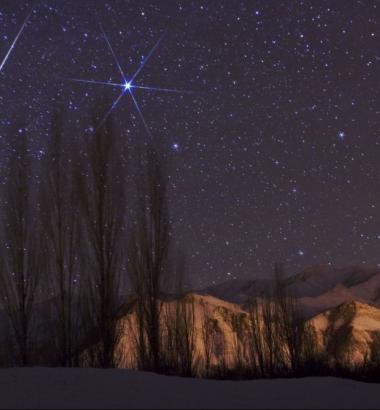
A Paean to Darkness
THE END OF NIGHT:
Searching for Natural Darkness in an Age of Artificial Light.
By Paul Bogard. Little, Brown. 325 pp. $27

THE END OF NIGHT:
Searching for Natural Darkness in an Age of Artificial Light.
By Paul Bogard. Little, Brown. 325 pp. $27
At age 18, Paul Bogard had a life-changing vision. Stepping outside his youth hostel at the edge of the Sahara, in a remote town where nomadic tribes gathered to barter and trade, he saw “a storm of stars swirl[ing] around me”: the night sky as he had never seen it before. Even his family’s cabin in rural Minnesota didn’t have views like this, almost completely untainted by human light pollution. “I saw the sky that night in three dimensions,” he writes. “The sky had depth, some stars seemingly close and some much farther away, the Milky Way so well defined it had what astronomers call ‘structure,’ that sense of its twisting depths.”
He was looking at what was already then a rarity—a sky that probably ranked a class 1 or 2 on the Bortle scale, a system for measuring light pollution that orders skies from 9 (brightest) to 1 (darkest) that was devised by amateur astronomer John Bortle in 2001. In the developed world, even rural nights rarely dip below a Bortle 3; the young Bogard was clearly struck by all the detail he had been missing. “The night pressed its impression,” he writes, “and a lifelong connection was sealed.” This sense of connection pervades The End of Night, Bogard’s paean to a type of deep darkness most Americans have lost to ever-brightening artificial lights.
Bogard, a James Madison University writing professor, builds a case that our view of the stars is a part of our cultural heritage worth preserving. This project took him to both light and dark places around the globe, a journey he organizes into chapters 9 through 1, in an echo of the Bortle scale. He started out in Las Vegas, where the intense beam shooting from the tip of the Luxor Hotel disrupts the feeding and migration patterns of local birds.
Neon glare isn’t the only way to light a city, Bogard points out. In France, for instance, the lighting designer François Jousse has made it his life’s work to illuminate Paris’s monuments with a soft, romantic glow; his techniques include setting lamps underneath bridges, so that pedestrians see by the shimmering reflection off the water below. Nor does dimmer lighting—such as the gaslights that still illuminate some London streets—necessarily give an advantage to muggers, Bogard says, citing several studies on urban crime. Instead, by forcing pedestrians’ eyes to adjust to darkness, it helps them see further into shadows where potential attackers could hide.
But in the United States, at least, it’s proven difficult to enact sweeping lighting changes based on what many regard asessentially aesthetic considerations—especially when most of the population doesn’t really appreciate the aesthetics in question. Though Flagstaff, Arizona, successfully passed anti–light-pollution legislation, the beauty of the stars is barely ever mentioned as a rationale. Instead, most citizens regard the law as necessary only to preserve the viewing power of a nearby observatory. To Bogard, this perspective seems limited. It is, as one astronomer he quotes put it, “like asking why the Grand Canyon is important and saying, ‘Oh, we need that so that the geologists can study the rocks.’”
Even practical reasons aren’t always enough to motivate people to dim the lights. An estimated 100 million birds die each year from collisions with human-built structures. This number could be reduced “overnight” by dimming the exterior lights that shine onoffice towers, according to one activist. Even risks to human health go largely ignored. Exposure to artificial lights may exacerbate the sleep disorders that affect 70 million Americans; by impeding the production of tumor-fighting melatonin, it may also contribute to an increased incidence of cancer among night-shift workers.
That may be why many of the dark-sky activists Bogard interviewed devote themselves to arranging epiphanies like the one he experienced in the Sahara. Park rangers in Maine lead unlighted night walks through Acadia National Park, inviting guests to test their natural adaptations in roughly Bortle class 2 darkness, often for the first time. By teaching people to appreciate the importance of darkness to “charismatic places we already love,” these advocates hope to overcome our “environmental generational amnesia”: We consistently underestimate how much darkness we have lost, since we have no way of knowing what night was like in our parents’ time, or our grandparents’. In this way, dark-sky experiences can expand our perspective not only out into the cosmos, but also back into the past.
Having a back-to-nature experience doesn’t always translate into changing one’s everyday surroundings. Bogard hints that one big obstacle to taming light pollution is NIMBYism—the “not in my backyard” attitude people adopt when they refuse to make a personal sacrifice for the sake of an agreed-upon societal good. A college-town police chief he interviewed blamed increased lighting on safety-obsessed parents who “couldn’t get campus bright enough”; a lighting engineer suggested that gas-station owners install brighter and brighter lights to compete with one another, since no one wants to be the dimmest business on the block.
It’s unfortunate that Bogard didn’t personally interview any of these NIMBYists. Their objections might have illuminated some of the challenges dark-sky advocates face even if educational efforts are successful. If other environmental campaigns have taught us anything, it’s that awareness alone is rarely sufficient for people to change their behavior. Even if it doesn’t contain the whole story, The End of Night makes a strong case that this debate should happen, and sooner rather than later.